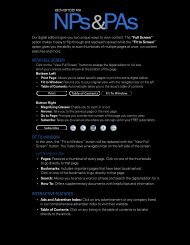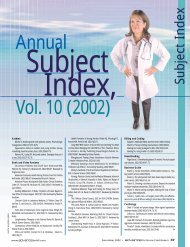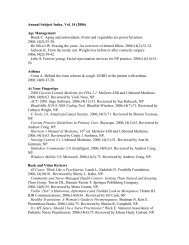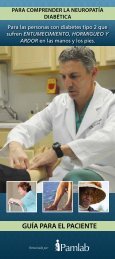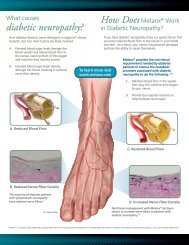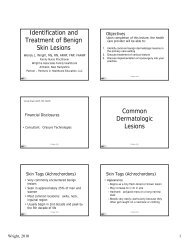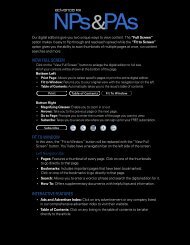CME/CE: Diabetesous hypoglycemia. Select a simple routineto get a patient started. Simplicity offersthe patient a chance to gain confidencein the routine be<strong>for</strong>e advancing to morecomplex regimens with multiple dailyinjections. 14 One of the easiest ways tostart insulin is to add an evening dose ofbasal insulin to the patient’s oral medications.4 Basal insulin includes NPH (neutralprotamine Hagedorn) and long-acting analogs(insulin glargine and insulin detemir).Advantages of the analog basal insulinsare their 24-hour duration, their oncedailydosing, their association with lesshypoglycemia (especially at night) andtheir predictable effects. Insulin detemir isalso associated with less weight gain than4,14, 24,16NPH or insulin glargine.Another clear advantage to addingbasal insulin is that it is relatively easyto calculate and order. When unsureabout the starting dose, it is safe to start10 units of basal insulin at bedtime asrecommended by the Treat-to-Targetstudy. 12,25,26 For patients with T2DM,the initial dose of basal insulin can beweight-based at 0.15 units/kg/day (0.1to 0.2 units/kg/day is the recommendedrange); however most patients require significantlymore insulin due to high levelsof insulin resistance. 8,11 Basal insulin canbe increased slowly to achieve a fastingglucose level of less than 100 mg/dL. Inthe Treat-to-Target study, average dailydoses required to reach goals were 0.48units/kg/day <strong>for</strong> insulin glargine and atleast two oral agents. That is equivalentto approximately 44 units of glargine perday <strong>for</strong> a patient who weighs 200 pounds(200/2.2 = 91 kg; 91 × 0.48 = 44 units).Basal insulin specifically targets fastingblood glucose, so another advantage isthat it is relatively easy <strong>for</strong> the patient totitrate with minimal assistance. For NPHinsulin, two delivery methods are available:The total dose can be divided in halfand given 12 hours apart, or two-thirdsof the dose can be given in the morningand one-third in the evening (to maximizethe prandial coverage midday). 14Another routine to consider is the use ofbiphased, premixed insulin preparations.This provides basal and postprandialcoverage in one injection. Studies indicatethat this routine can help patientsreach glycemic goals adequately. However,premixed preparations do not allow the“fine tuning” of administration that basal–bolus therapy does. This type of insulin ismore appropriate <strong>for</strong> patients who desirea simpler routine that requires injectinginsulin only twice a day; it provides basalas well as prandial coverage. 3,4,19 Premixedinsulin can initially be added to the largestmeal of the day, and then a second dosecan be added at breakfast. To calculatethe starting dose of premixed insulin, use0.2 units/kg/day as the basic <strong>for</strong>mula andgive it in two equal divided doses rightbe<strong>for</strong>e a meal. 16 Patients who use premixedinsulin need to be assessed frequently <strong>for</strong>hypoglycemia; they also should keep afairly consistent routine. 4Choice of insulin routine dependson many factors, including providerpreference and patient issues such asconvenience and willingness to injectonce or multiple times daily. Table 3outlines the primary considerations.Patients can continue their oral medicationsafter adding insulin — with theexception of sulfonylureas, due to the highrisk <strong>for</strong> hypoglycemia. 27 Continuation ofmet<strong>for</strong>min assists in improving insulinsensitivity because it reduces gluconeogenesisand the dose of insulin needed.It also assists with weight maintenance.Glucagon-like peptide (GLP-1) analogssuch as exenatide can be continued withmet<strong>for</strong>min. 12,28Managing and Titrating InsulinSeveral methods <strong>for</strong> titrating insulin areavailable, and simple adjustment schedulescan be easily implemented by patients.Every 3 days, if the patient’s fasting glucoselevel is above 130 mg/dL, basal insulincan be increased by 2 units. For glucosereadings that are below 70 mg/dL, basalinsulin can be reduced by 10%, or 4 units.Severe reactions warrant a phone call oroffice visit with the prescriber. 14It is important to also consider addingprandial coverage be<strong>for</strong>e the basal dosereaches 0.5 units/kg/day. So, in the caseof Ms. Jones, prandial insulin should beadded when her basal dose approaches 45to 55 units daily (244 pounds or 111 kg;110 kg/2 = 55 units of insulin).Prandial coverage can be providedby rapid-acting analog or short-actingregular insulin. As with the analog basalinsulins, the rapid-acting analogs moreclosely mimic physiologic insulin secretion.Their clear advantage over regularinsulin is that they take effect within 10to 15 minutes, peak in 30 to 90 minutesand last <strong>for</strong> only 3 to 5 hours. Becausethey are absorbed more rapidly thanregular insulin, the analogs can be givenright be<strong>for</strong>e a meal and they have a morepredictable duration that will help avoidhypoglycemia. 16Prandial coverage is managed in severalways. 4 The easiest technique is to have theTable 2Insulin Characteristics and Duration of Action 4,8,9Insulin Onset Peak DurationLispro (Humalog) 10–15 min 15–120 min < 5 hrAspart (Novolog) 10–15 min 15–120 min < 5 hrGlulisine (Apidra) 10–15 min 15–120 min 5 hrRegular (R) 30–60 min 2–3 hr 6–8 hrNPH (N) 2–4 hr 6–10 hr 10–16 hrGlargine (Lantus) 2–4 hr No peak 20–24 hrDetemir (Levimir) 1 hr No peak 20–24 hr70%/30%Aspart protamine/aspart50%/50%NPL/lispro75%/25%NPL/lispro30 min 2–12 hr 10–16 hr30 min 3–5 hr 10–16 hr15 min 30–90 min 10–16 hrNPH = neutral protamine Hagedorn; NPL = neutral protamine lispro<strong>ADVANCE</strong> <strong>for</strong> <strong>NPs</strong> & <strong>PAs</strong>23
CME/CE: DiabetesTable 3Insulin Regimens Tailored <strong>for</strong> Patient Conditions 14–16,21,27,35,37–39Insulin Regimens A 1c Level Glucose Pattern Patient Conditions Treatment Option Monitoring of SMBGBasal onlyA 1c greaterthan 7.5%to 10%High fasting glucoseSome postprandialhyperglycemia (canbe managed withOADs)Reluctant to do MDIStill on oral medsLess aggressivegoals of therapyFears injections1. Insulin glargine ordetemir daily2. NPH at bedtime3. NPH twice dailyFasting glucoseBasal–bolus (MDI)A 1c greaterthan 7.5%Can be matched toany glucose pattern<strong>for</strong> controlHighly motivatedPoor control on basalonlyNeed <strong>for</strong> moreaggressive therapyDesires tight controlWilling to test bloodglucose at least 4times dailyUnpredictableschedule1. Basal daily2. Add prandialcoverage be<strong>for</strong>elargest meal3. Gradually increaseprandial coveragebe<strong>for</strong>e other 2 mealsAllows <strong>for</strong> flexibleschedule with meals,injectionsMinimum be<strong>for</strong>eeach meal and atbedtimePremixed insulinwith rapid-actinganalog andintermediate-actingORregular and NPHOnce or twice dailyA 1c greaterthan 7.5%Fasting glucoseelevatedGlucose rises duringdayReluctant to do MDIConsistent dailyroutineOpposed to middayinjectionsFasting and be<strong>for</strong>esupper if given twicedailyOADs = oral antidiabetic drugs; MDI = multiple daily injections; SMBG = self-monitoring of blood glucosepatient give a fixed amount prior to eachmeal, but that does not allow <strong>for</strong> adjustmentsbased on current glucose level orthe anticipated carbohydrate ingestion.To get started, the patient can take 5 unitsof rapid-acting insulin (or about 7% of thedaily dose of the basal insulin) be<strong>for</strong>e eachmeal. 4 Another technique is to have thepatient calculate the premeal dose basedon the glucose reading right be<strong>for</strong>e themeal, following a sliding scale developed<strong>for</strong> him or her. And a preferred methodis to give both prandial and correctionalinsulin just be<strong>for</strong>e the meal based on theanticipated carbohydrate ingestion. Thisrequires counting carbohydrates correctlyand adjusting the insulin dose.Usually, predetermined insulin-tocarbohydrateratio is used to predict theamount of insulin to be given. A commonratio is 1:10, which means that thepatient will give 1 unit of insulin <strong>for</strong> each10 grams of carbohydrates in the meal.The ratio can be changed depending onblood glucose readings and amounts ofcarbohydrates eaten at each meal; thepatient may have a different ratio <strong>for</strong>each meal. This kind of routine is morecomplex and requires a highly motivatedpatient who can attend diabetes classesor individual sessions with a diabeteseducator or dietitian. 4Adding prandial coverage requires thatpatients monitor blood glucose levels morefrequently. The recommended routine <strong>for</strong>checking glucose levels is at least 4 timesa day — be<strong>for</strong>e each meal and at bedtime.Patients should bring glucose logs or theirglucose meter to all appointments. Usingthis data, the clinician can make moreaccurate adjustments in insulin dosesto avoid hypoglycemia and prolongedexcursions of hyperglycemia. 3Case 1: Basal–Bolus InsulinConsider the following example of Mr.Smith, a 62-year-old man who was diagnosedwith T2DM 4 years ago. He is currentlytaking insulin glargine 22 units aday and 6 units of prandial coverage threetimes a day, be<strong>for</strong>e meals. His glucose levels<strong>for</strong> several days are shown in Table 4.Mr. Smith is experiencing higher fastingreadings each morning and higher levelsafter supper and be<strong>for</strong>e bedtime. If he istaking both basal and prandial insulin, theappropriate adjustment is to increase hisbasal insulin by 2 units to target fastingblood glucose levels (increase to 24 unitsdaily) and increase rapid-acting analogbe<strong>for</strong>e supper by 1 to 2 units (increase to7 to 8 units). Mr. Smith should continueto monitor his blood glucose levels andreport them after 1 to 2 weeks <strong>for</strong> furtheradjustments. All patients should reportepisodes of hypoglycemia <strong>for</strong> immediatedose reduction, if needed.Giving basal–bolus insulin can bemore challenging, but it provides thebest physiologic match to endogenousinsulin profiles. It is also more flexiblebecause it allows <strong>for</strong> variable mealtimesand routines. Approximately 50% of thetotal daily dose of insulin should be basalinsulin and the rest should be given as24 <strong>ADVANCE</strong> <strong>for</strong> <strong>NPs</strong> & <strong>PAs</strong>



